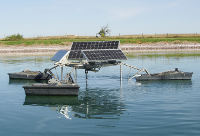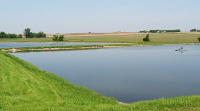Residents of agricultural Garretson, SD, pop. 1,166 -- 20 miles northeast of Sioux Falls -- suffered through an “odor event” from the wastewater treatment plant every spring.
“For several weeks, odors would roll over the whole town when the wind was from the right direction,” said Craig Nussbaum, utilities superintendent for Garretson. “We work on limited funds, so there wasn’t much we could do. We hoped the weather would take care of it.” Weather being weather, of course, it rarely cooperated.
But while looking through a magazine one day, Nussbaum learned about SolarBee® mixers from Medora Corp. and thought they might be the answer to the odor problem.

“They’re in neighboring North Dakota, so I decided to give them a call,” said Nussbaum.
Garretson’s total-containment wastewater treatment system consists of 7 ponds or cells totaling 35.2 surface acres and 46.8 MG. The cells are no more than 5 ft deep and rely on evaporation to remove water. SolarBee engineers recommended that Nussbaum install a solar-powered mixer in each of 2 ponds, both to control odors and help reduce organic digestive sludge buildup.
Water’s Ability to Form Layers
Operators like Nussbaum have several options for coping with pond odors, from increasing the aeration to applying chemicals to the water or perfume to the air. But often these solutions are expensive and not totally effective.

Another alternative — long-distance circulators or mixers — has emerged as an economical, effective solution for controlling wastewater pond odors. Installed on the pond’s surface, SolarBee long-distance mixers consist of: a solar-powered or electric-powered motor; an axial flow impeller that pulls water up from the intake to the surface, where is it spread out at 360 deg; an adjustable-depth intake hose; and a power control system.
“Long-distance circulators are different from other reservoir equipment because the adjustable intake takes advantage of the manner in which water forms thin horizontal layers in ponds,” said Michael Christensen, East U.S. manager, SolarBee. “A precise horizontal cross-section of water circulates throughout the entire pond footprint.”
Spring Is In the Air
At Garretson, SolarBee mixers circulate the top 3 ft of the 5 ft pond, essentially mixing and oxygenating the top layer of the pond. When sulfide gas bubbles rise toward the surface of the pond, they are instantly oxidized to non-odorous sulfate as they pass through this oxygenated odor “cap.”
SolarBee mixers maintain the oxygen in the odor cap through two mechanisms: 1) by capturing photosynthetic oxygen during the daylight hours; and 2) through surface re-aeration during the nighttime hours. Since the machine is not bringing up any BOD loading from deeper water because there is no turbulence, usually there is no problem in maintaining oxygen in the odor cap 24 hours per day.
Mixing the pond also helps sludge settle out and be digested. Constantly removing surface film allows methane to escape the pond more easily. This increases anaerobic digestion and reduces sludge volume.
Now, Garretson residents can look forward to smelling spring in the air instead of the treatment plant. The circulators have been installed for 5 years, and “We don’t notice anything in the spring anymore,” said Nussbaum.





